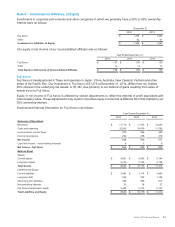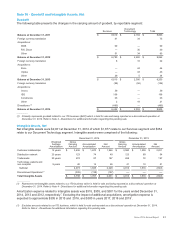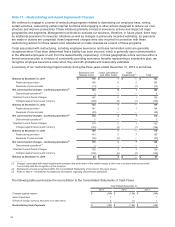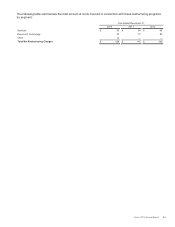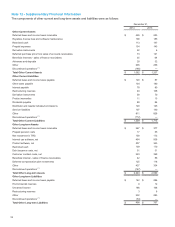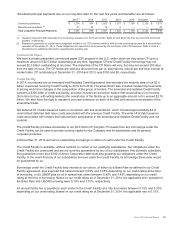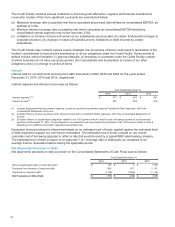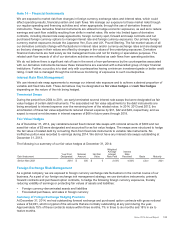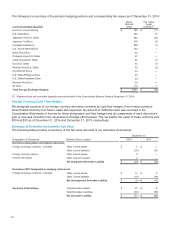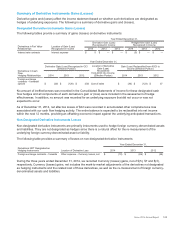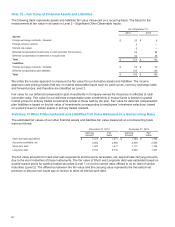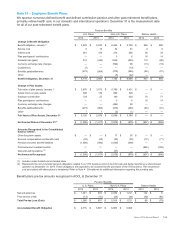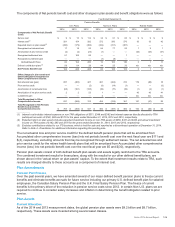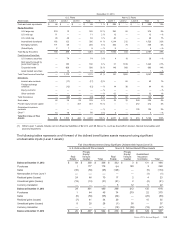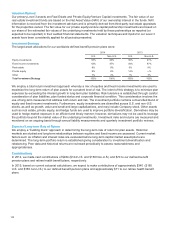Xerox 2014 Annual Report Download - page 115
Download and view the complete annual report
Please find page 115 of the 2014 Xerox annual report below. You can navigate through the pages in the report by either clicking on the pages listed below, or by using the keyword search tool below to find specific information within the annual report.
Note 14 – Financial Instruments
We are exposed to market risk from changes in foreign currency exchange rates and interest rates, which could
affect operating results, financial position and cash flows. We manage our exposure to these market risks through
our regular operating and financing activities and, when appropriate, through the use of derivative financial
instruments. These derivative financial instruments are utilized to hedge economic exposures, as well as to reduce
earnings and cash flow volatility resulting from shifts in market rates. We enter into limited types of derivative
contracts, including interest rate swap agreements, foreign currency spot, forward and swap contracts and net
purchased foreign currency options to manage interest rate and foreign currency exposures. Our primary foreign
currency market exposures include the Japanese Yen, Euro and U.K. Pound Sterling. The fair market values of all
our derivative contracts change with fluctuations in interest rates and/or currency exchange rates and are designed
so that any changes in their values are offset by changes in the values of the underlying exposures. Derivative
financial instruments are held solely as risk management tools and not for trading or speculative purposes. The
related cash flow impacts of all of our derivative activities are reflected as cash flows from operating activities.
We do not believe there is significant risk of loss in the event of non-performance by the counterparties associated
with our derivative instruments because these transactions are executed with a diversified group of major financial
institutions. Further, our policy is to deal only with counterparties having a minimum investment grade or better credit
rating. Credit risk is managed through the continuous monitoring of exposures to such counterparties.
Interest Rate Risk Management
We use interest rate swap agreements to manage our interest rate exposure and to achieve a desired proportion of
variable and fixed rate debt. These derivatives may be designated as fair value hedges or cash flow hedges
depending on the nature of the risk being hedged.
Terminated Swaps
During the period from 2004 to 2011, we early terminated several interest rate swaps that were designated as fair
value hedges of certain debt instruments. The associated net fair value adjustments to the debt instruments are
being amortized to interest expense over the remaining term of the related notes. In 2014, 2013 and 2012, the
amortization of these fair value adjustments reduced interest expense by $31, $42 and $49, respectively, and we
expect to record a net decrease in interest expense of $68 in future years through 2018.
Fair Value Hedges
As of December 31, 2014, pay variable/received fixed interest rate swaps with notional amounts of $300 and net
asset fair value of $5 were designated and accounted for as fair value hedges. The swaps were structured to hedge
the fair value of related debt by converting them from fixed rate instruments to variable rate instruments. No
ineffective portion was recorded to earnings during 2014. We did not have any interest rate swaps outstanding at
December 31, 2013.
The following is a summary of our fair value hedges at December 31, 2014:
Debt Instrument
Year First
Designated
Notional
Amount
Net Fair
Value
Weighted
Average
Interest
Rate Paid
Interest
Rate
Received Basis Maturity
Senior Note 2021 2014 $ 300 $ 5 2.43%4.50% Libor 2021
Foreign Exchange Risk Management
As a global company, we are exposed to foreign currency exchange rate fluctuations in the normal course of our
business. As a part of our foreign exchange risk management strategy, we use derivative instruments, primarily
forward contracts and purchased option contracts, to hedge the following foreign currency exposures, thereby
reducing volatility of earnings or protecting fair values of assets and liabilities:
• Foreign currency-denominated assets and liabilities
• Forecasted purchases, and sales in foreign currency
Summary of Foreign Exchange Hedging Positions
At December 31, 2014, we had outstanding forward exchange and purchased option contracts with gross notional
values of $2,991, which is typical of the amounts that are normally outstanding at any point during the year.
Approximately 75% of these contracts mature within three months, 7% in three to six months and 18% in six to
twelve months.
Xerox 2014 Annual Report 100


